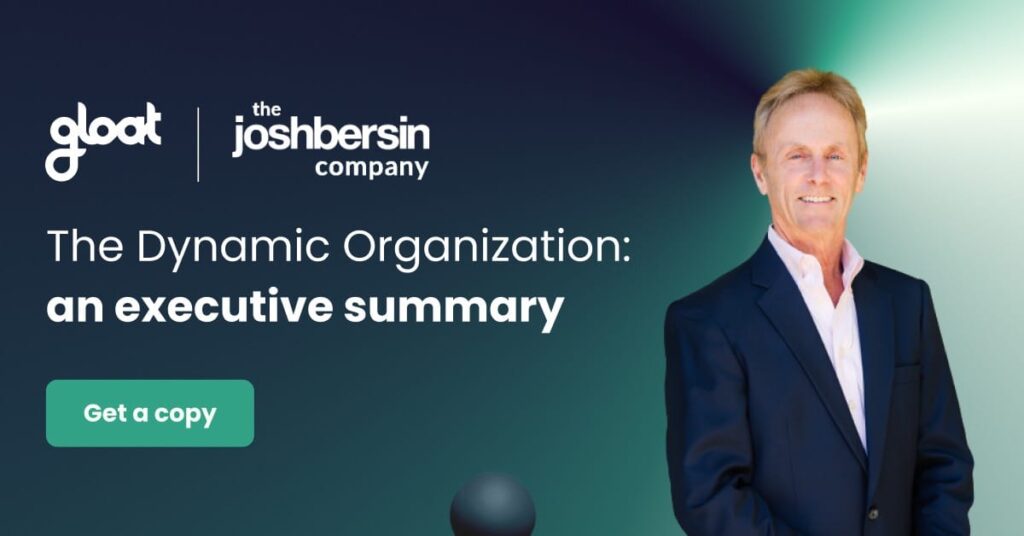What is “dynamic leadership” and why is it working?
Learn which tactics delivered the highest impact in 2024

As leaders step back and finetune their strategies for 2024, they are likely weighing many actors. From navigating hiring strategies in a skill shortage, finding ways to adopt new AI technology, navigating hybrid work, rethinking career development, and more, HR leaders are balancing a lot to support the future needs of their businesses. And they’re doing it to enable bigger transformations like digital acceleration, supporting ambitious sustainability goals, and finding ways to hit ambitious growth targets.
So, where do you start? Which of these tactics provides the best foundation? After teaming up with The Josh Bersin Company to analyze nearly 800 organizations, we found that while individual tactics and focus areas do make an impact, the most successful businesses approach their talent strategy entirely differently from their competitors. In fact, we’ve put them in a category all of their own called Dynamic Organizations.
Dynamic Organizations look beyond risk mitigation and efficiency and build talent strategies focused on business growth instead. In doing so, they’ve embraced agile operating models, created cultures of collaboration and growth, and made commitments to ongoing transformation rooted in market insights and data. As a result of these differentiated practices, these businesses enjoy significant advantages, including a 3X greater likelihood of hitting financial targets and a 7X better chance of innovating effectively.
Like any organizational change, becoming dynamic starts at the top, with leadership. There are a few steps executives can take to encourage more fluid and flexible ways of working across their organizations.
What is dynamic leadership
Dynamic leadership is the ability to lead with adaptability, emotional intelligence, and vision in response to changing conditions. It empowers leaders to inspire teams, promote growth, and navigate uncertainty with resilience. Dynamic leaders drive progress by embracing change rather than managing the status quo.
What is a dynamic leadership model?
A dynamic leadership model is a framework that guides leaders in adapting to change, fostering innovation, and driving team performance. It combines flexibility, vision, emotional intelligence, and continuous learning to help leaders respond effectively to evolving challenges and lead with resilience.
Employees are not confined to the responsibilities of the job they were hired for, but instead encouraged to participate in projects across the organization based on the skills they have and the capabilities they wish to build. This new operating model requires a unique leadership style in which executives encourage cross-functional collaboration, ensure talent decisions are rooted in skills, and value ideas and innovations from all levels of their organization.
Leaders of Dynamic Organizations must create cultures of growth and inclusion and focus on continuously skilling their workforces. They must also harness next-generation technologies to help them place people in the right roles and on the right projects and redesign work to be flatter and more team-based.
5 capabilities every dynamic leader needs
If you’re looking to embrace a more dynamic style of management, here are a few qualities to prioritize:
#1. Resilience
Leaders at Dynamic Organizations must recognize that business needs will constantly evolve as the market shifts and consumer demands change. Creating strategies amidst ongoing uncertainty is challenging, but dynamic leaders aren’t intimidated by the ever-changing nature of the working world. Instead, they adapt their approaches accordingly.
Many harness AI-powered talent management systems like skills intelligence tools to gain ongoing insight into the capabilities their workforce has as well as keeping a pulse on which skills are trending in their industry. When leaders encounter challenges, they harness these tools to identify employees with the expertise needed to tackle the obstacle their organization is facing.
#2. Visionary thinking
Dynamic operating models represent an entirely new way of thinking. While there are many benefits associated with these strategies, some leaders may be hesitant to experiment with an emerging management style and different ways of allocating talent resources.
Executives who are truly committed to being dynamic recognize that the fallout from any transitional challenges they encounter will pale in comparison to the long-term benefits Dynamic Organizations reap. These leaders know that dynamic operating models are the work strategy of the future and they don’t shy away from embracing it.
#3. Emotional intelligence
A growth mindset and culture of inclusion are hallmarks of Dynamic Organizations—and it falls on leaders to set the tone for this. Executives must empower employees to take on new projects across their organization so they can expand their professional networks, build new skills, and get comfortable working with colleagues of different backgrounds and seniority levels.
To fuel ongoing cross-functional collaboration many dynamic leaders look to talent marketplaces as a key action platform. These systems generate suggestions for projects, gigs, and mentorships that align with employees’ skills and career goals, in turn empowering everyone to step outside of their comfort zones.
#4. Effective communication
Rather than fearing change, Dynamic Organizations are designed to embrace it head-on. However, companies will only be able to adapt successfully if employees feel like they’re being kept in the loop about strategy shifts and the reasoning behind them. In order to keep everyone on the same page, leaders must demonstrate robust communication skills and look beyond a top-down approach to messaging. Dynamic leaders will give employees the opportunity to have their pressing questions answered and share feedback on the changes being made.
#5. Inclusive mindset
Dynamic leaders recognize that every employee brings their own unique blend of interests and skills to the table—and they create pathways to ensure these abilities are nurtured throughout the employee lifecycle.
Rather than relying on seniority level or rank to determine who should work on which projects, dynamic leaders tap skills intelligence tools and talent marketplaces to see which employees are the best fit for the opportunity based solely on their skills and experiences. By removing favoritism and potential biases from the equation, these executives can in turn cultivate an inclusive culture that’s designed to bring out everyone’s best.
Why dynamic leadership is crucial for organizational success
Now that we’re in the Post-Industrial era, Dynamic Organizations will become the dominant work strategy for a few reasons.
#1. Enhanced productivity
While leaders at static companies break down work into jobs, dynamic executives take a skills-centric approach to career mobility decisions in which talent is continuously reallocated to open opportunities based on capabilities and capacity. By removing the silos that typically limit peoples’ scope of work, employees at Dynamic Organizations are empowered to put their skills to use across the entire enterprise.
#2. Better employee engagement
Dynamic leaders understand that job titles and levels of seniority don’t dictate which ideas should be valued. Instead, these companies are what The Josh Bersin Company calls “skills meritocracies”. As their Senior Vice President of Research Kathi Enderes explains, “We call it a meritocracy because the best ideas win, regardless of where they come from. That means you have a psychologically safe culture because people can speak up, whether or not they’re at the top of the pyramid.”
This flatter and more egalitarian talent management approach empowers everyone to share their thoughts and contribute to projects across the organization, in turn boosting workplace satisfaction. Overall, Dynamic Organizations are 31X more likely to engage their employees compared to their static counterparts.
#3. Employee retention
Employees are eager to stay at companies where they know they won’t be pigeonholed into a specific role or responsibility. Leaders at Dynamic Organizations encourage their people to move around and participate in projects within many different teams and departments, which helps everyone build new skills and strengthen their professional networks.
#4. Adaptability
Since disruption is a constant in our Post-Industrial era, an organization’s ability to strategically respond to change will make or break its chances for success. Leaders at Dynamic Organizations are in the best position to proactively address new challenges and sudden shifts because these companies’ strategies are based on market insights and data.
Leaders can reallocate talent and create new cross-functional teams on the fly to overcome any emerging obstacles their company might face. Overall, Dynamic Organizations are 5X more likely to adapt to change well.
How to cultivate dynamic leadership skills
Rather than waiting until employees move into management positions, leadership skills should be developed at every level of the organization, particularly if executives are eager to follow a dynamic style of leadership. Soft skills such as communication, conflict resolution, and coaching are valuable throughout an employee’s career and will help more junior-level workers navigate challenging situations thoughtfully.
As employees move into management positions, these soft skills will become even more important. Since talent is continuously being reallocated at Dynamic Organizations, leaders and managers must negotiate and optimize this free-flowing exchange of skills and opportunities.
To help employees begin building their leadership skills, many businesses are introducing talent marketplaces. These platforms give employees the opportunity to pitch in on projects across their organization and develop valuable soft skills. Employees can also get matched to a mentor so they receive one-on-one guidance on how to build the skills they’ll need to eventually lead with confidence.
To learn more about the tools and strategies businesses are using to embrace more adaptive ways of working, check out The Dynamic Organization research we collaborated with The Josh Bersin Company to produce.





